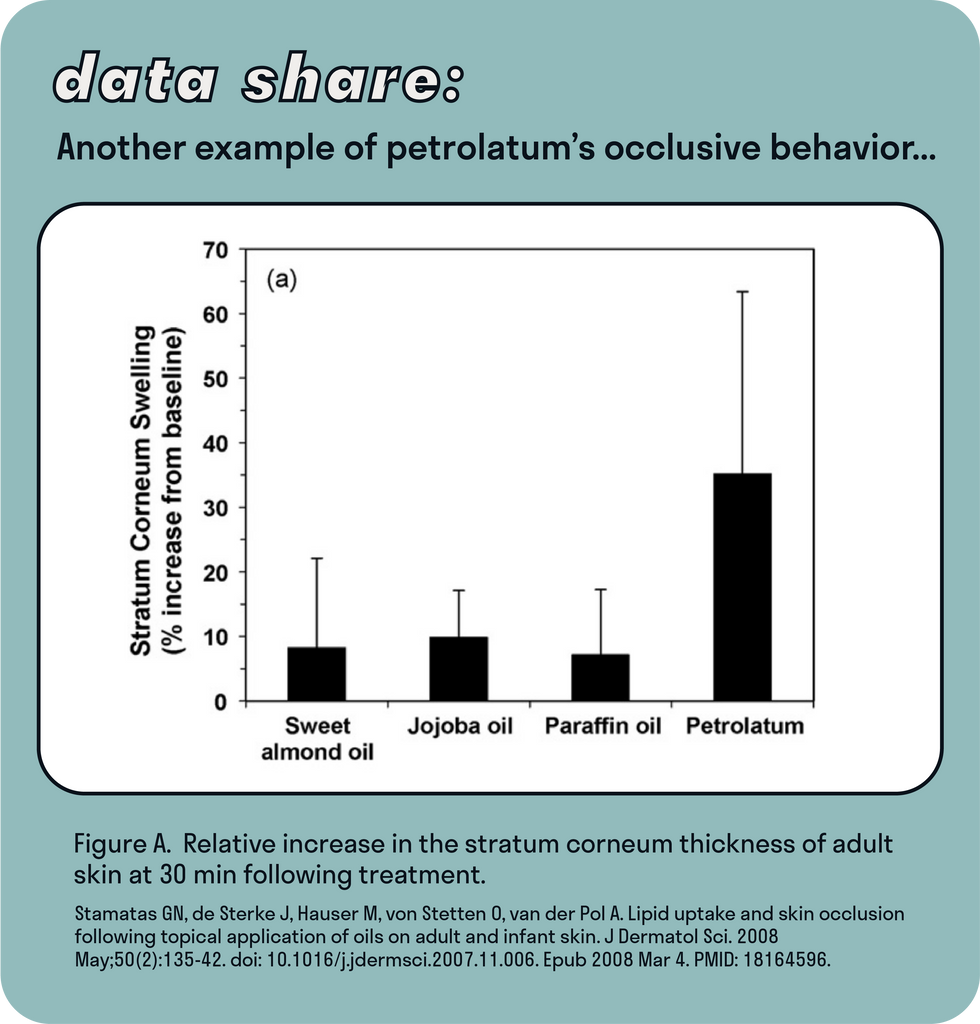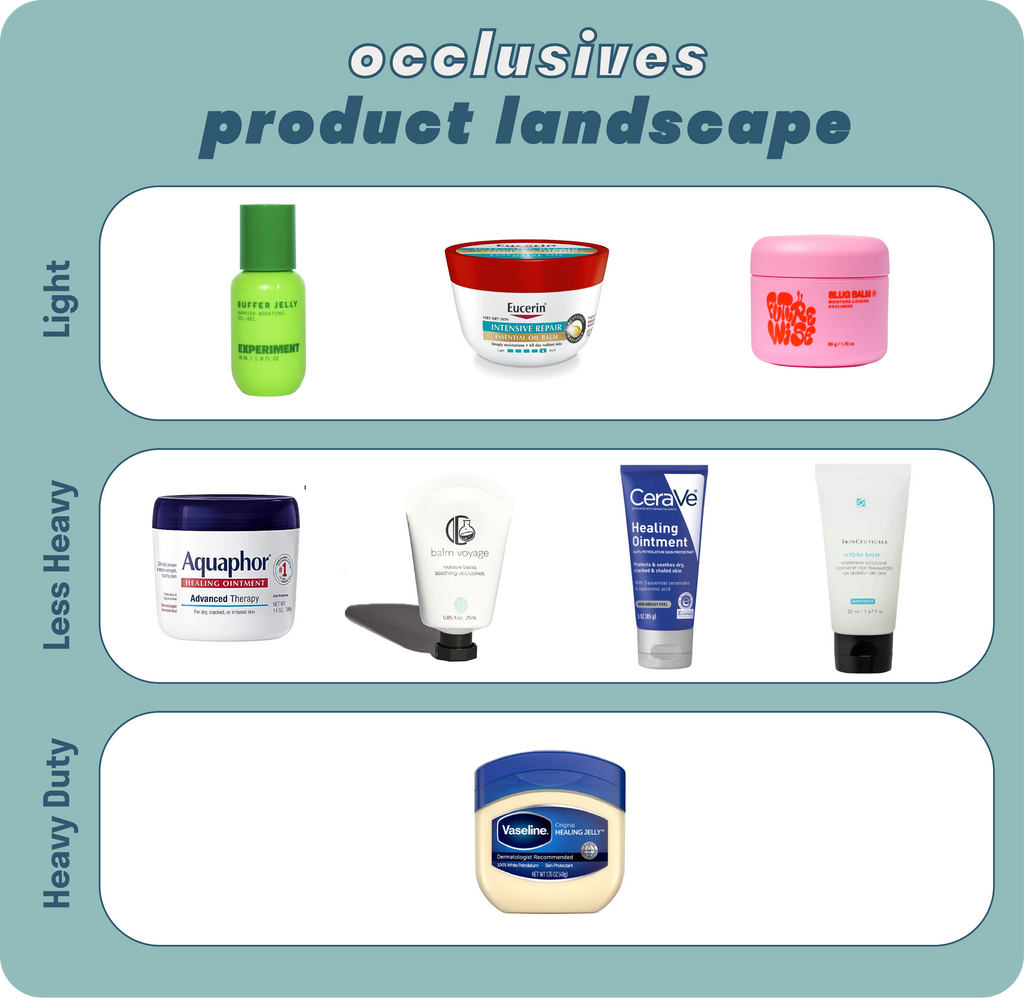In the past couple of years, “slugging” has become one of the biggest social media skincare trends that seemingly is here to stay. The term has been coined by the interwebs as the process of masking your entire face with an occlusive balm to seal in your moisturizer step for optimal hydration. While the method of slugging might not be for every skin type, the operative word here is occlusive. Occlusives are a fundamental category of moisturizing ingredients that are an essential component to comprehensive skin hydration and skin barrier health that can benefit every skin type (when used correctly). Here, we’ll discuss how occlusives work, what they can (and can’t) do for skin, the controversy around petrolatum, how to find your next occlusive skincare product, and whether or not you should be slugging regularly.
What is an occlusive?
Occlusives are fatty, waxy, oily substances that help seal in skin’s moisture and prevent excessive TEWL (Trans Epidermal Water Loss). While TEWL is a normal process for the upkeep of skin health, excessive TEWL is what inevitably leads to dry skin. In fact, measuring TEWL is one of the most common testing methods to evaluate skin condition.
What does slugging do for skin?
The method of occlusion originally started in wound healing with physical dressings to occlude wounds and prevent infection. In skincare, occlusives are waxy, fatty, oily substances that don’t necessarily absorb well into skin and instead help to create a seal, effectively preventing passive TEWL (transepidermal water loss). Slugging - the act of slathering a thick layer of occlusives on skin before bed - is essentially an intensive way of really sealing in that moisture for the night. Think of it as an emergency, in-a-pinch method to re-calibrate parched, dry, irritated skin. It can be helpful when skin is going through a dry patch, say right after a flight.
Does slugging work? Occlusives in Clinical Studies
We have a lot of skeptics asking: does slugging actually work? This concept can actually be demonstrated with some clinical evidence. A lab in Sweden wanted to understand the impact of applying a well known occlusive, petrolatum, on skin vs. two topical creams under two different scenarios:

Scenario 1: Apply the product on skin. Remove after 5 minutes and measure for TEWL.
They found that after 5 mins, TEWL increased for these cream emulsions vs. the occlusive.
Scenario 2: Apply the product on skin. Remove after 40 minutes and measure for TEWL.
They found that the inverse occurred where TEWL increased for occlusives vs. creams.
In scenario 1, the reasoning for this almost immediate increase in TEWL for both creams is that the water within the cream was released and contributed to this spike in skin water loss. It’s also theorized that some contribution is from water that was absorbed by skin as well. For petrolatum, there’s no change simply because petrolatum does not contain water and it has not been applied to skin long enough to cause any change in TEWL.
However, in scenario 2 the reverse is seen. In this 40 minute time period, it appears that petrolatum created a fairly good “seal” that causes almost a “build up” of water. So when the petrolatum was removed, you see a temporary spike/release of excess water. The creams have a similar effect, but to a much lesser extent. From this study, we can gather that petrolatum does effectively prevent TEWL in a greater capacity compared to moisturizers.

Let’s look at one more study done by Johnson & Johnson, they wanted to compare the occlusive behavior of petrolatum to paraffin oil, jojoba oil, and sweet almond oil. They used Raman microspectroscopy to measure the lipid content and water concentration profile to calculate stratum corneum (the outermost layer of the epidermis) thickness. The thicker the stratum corneum, the more water that has been retained within skin. They found that after applying petrolatum on skin for 30 minutes, they found that the stratum had swelled by ~40-60% compared to the other oils that averaged around ~10-20% swelling.
From the two studies here, the takeaway is that occlusives like petrolatum are effective at reducing TEWL and preventing water from evaporating from skin. Healthy skin typically holds 10-20% water content. Applying an occlusive can block diffusional water loss from skin, which increases stratum corneum hydration, swelling the corneocytes, and promote water uptake even within the skin’s lipid domans. (Think juicy!)
Best Occlusive Skincare Ingredients
Convinced and ready to pick the best slugging pingredient? Petrolatum is the gold standard simply from the sheer amount of clinical testing. Other traditional occlusive ingredients include: beeswax, dimethicones, and butters.
Additionally, you might also wonder if emollient oils like jojoba and sweet almond oil also have occlusive properties. The simplified answer is, “it depends!”. Some do and some just haven’t been tested under this capacity to really know. This is why we recommend starting in the traditional category of petrolatum, butters, and waxes if you’re just starting your occlusives journey.
Shopping for the Best Occlusive Products

Which product is best for slugging can depend on your skin type, skin condition. The best way to think about it from the chemists' perspective is to shop based on the level of occlusion that's right for you:
- Very light occlusion: This category probably has the highest variance. This could span anything from a very high wax cream to face oils. “Sleeping masks” could fall into this category but we recommend giving the ingredient list a skim for waxes and butters to show up in the first few ingredient spots. This category can be enough for those with more oily skin. However, if you’re dry and your skin is prone to developing flaky spots, this category is probably not going to give you the full benefit of occlusives.
- Mid-level occlusion: These products typically come as petrolatum blends. You’re looking at anything with ~30%petrolatum and higher (such as Aquaphor and our very own Balm Voyage). The nice part about this category is that these textures are often lighter and more absorbent than the next category: “Max Occlusion”. Most skin types can benefit from this category. This is also a category where you can choose products based on secondary benefits outside of occlusion. Our Balm Voyage in particular uses Boswellia Serrata to sooth and 1% ceramide to further fortify your skin barrier.
- Max Occlusion: This is Vaseline aka. 100% petrolatum. This can be a great economical first try in the occlusion category especially for sensitive skin types simply because it’s a single-ingredient product that has been tested time and time again as an effective skin protectant and TEWL reducer. If you have tried say an Aquaphor and it doesn't feel enough for your dry patches, it's time to give Vaseline a go.
Using Occlusives in Your Skincare Routine
Since occlusvies work by “sealing” everything in, this should definitely be the last step in your routine. Consider occlusives as your handy dandy Mr. Fixit skin tool. This isn’t a product that you may need nightly, but it is incredibly helpful to have at the ready when skin might have a fussy moment. Consider traveling with this product especially if you’re headed to different climates or know your skin is more prone to dry patches. An occlusive balm doesn’t necessarily need to be applied all over face. You can spot treat those dry patches, or apply a thin layer to a larger area.
Though occlusives are very help, this is just 1 of 3 major categories of moisturizing ingredients. So just keep in mind that an occlusive balm is a supplement to your routine, but not a replacement for your moisturizer.
Top Slugging Tips
Slugging is the method of applying an occlusive all over face (like a mask) as a final step to your skincare routine to seal in your skin’s moisture. Whether or not you should slug, really depends on your skin needs. It can be a great final step for dry skin types, especially in the wintertime. How often you “slug” also varies. Some feel need to slug nightly during incredibly dry, heater-intensive winters, while others may slug once every month. There’s also many they may not need to slug at all. For oily and acne-prone skin types it’s much more common to simply spot treat dry areas (especially when onboarding retinoids and acne topicals) than slugging.
Takeaways/FAQ
What is an occlusive?
Occlusives are mainly butters, waxes, and petrolatum ingredients that seal in skin’s moisture and prevent dry skin.
Why is petrolatum the gold standard occlusive?
Petrolatum has been used in skincare for a long time with a solid amount of testing that demonstrates its superior ability to reduce TEWL and seal in moisture in a short period of time.
Is petrolatum safe to use?
Because of petrolatum’s long history of use, this material has been under a lot of scrutiny by various international regulating bodies. Petrolatum has been put through repeated safety testing and has been deemed safe to use for skin and is not carcinogenic.
How do I use an occlusive?
Occlusives can be used as either a spot treat when anticipating dry skin patches or as a last step to your skincare routine to seal in skin’s moisture content. To slug, apply the occlusive product on full face.
Is slugging good for my skin?
Slugging is not a necessary step to your routine and depends more on your skin type. Slugging is a good fit for dry skin types, especially during the winter months. Think of this as more of a “in a pinch” method rather than something you do on the regular.
References
Zhai, H. and Maibach, H.I. (2001), Skin occlusion and irritant and allergic contact dermatitis: an overview. Contact Dermatitis, 44: 201-206. https://doi.org/10.1034/j.1600-0536.2001.044004201.x
Buraczewska, I., Broström, U., & Lodén, M. (2007). Artificial reduction in transepidermal water loss improves skin barrier function. British Journal of Dermatology, 157(1), 82–86. doi:10.1111/j.1365-2133.2007.07965.x
Walter, Jason. “Petrolatum and Regulatory Requirements.” Penreco®, 27 July 2023, penreco.com/petrolatum-and-regulatory-requirements/#:~:text=The%20USP%2C%20for%20example%2C%20sets,categories%20is%20the%20maximum%20color.
Lodén M. The increase in skin hydration after application of emollients with different amounts of lipids. Acta Derm Venereol. 1992 Sep;72(5):327-30. PMID: 1361276.
Stamatas GN, de Sterke J, Hauser M, von Stetten O, van der Pol A. Lipid uptake and skin occlusion following topical application of oils on adult and infant skin. J Dermatol Sci. 2008 May;50(2):135-42. doi: 10.1016/j.jdermsci.2007.11.006. Epub 2008 Mar 4. PMID: 18164596.



